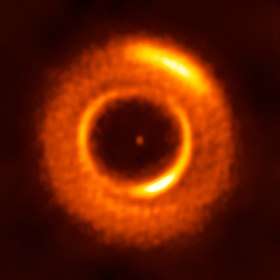HD 36112
HD 36112 is a Herbig Ae star located in the constellation Taurus and the young star is surrounded by irregular rings of cosmic dust. The system is about 3.5 million years old. The disk has a cavity at 50 astronomical units and two spiral arms at 30-75 au that are seen in near-infrared scattered light, but only one spiral arm is seen in ALMA images.[3][4]
 HD 36112 and the surrounding dusty disk. The rings in the disk were measured as being elliptical in shape rather than being perfectly circular. Credit: ESO/R. Dong et al.; ALMA (ESO/NAOJ/NRAO) | |
| Observation data Epoch J2000 Equinox J2000 | |
|---|---|
| Constellation | Taurus |
| Right ascension | 05h 30m 27.52868s |
| Declination | 25° 19′ 57.0822″ |
| Characteristics | |
| Spectral type | A8Ve[1] |
| Astrometry | |
| Proper motion (μ) | RA: 3.586 ± 0.112[2] mas/yr Dec.: -26.751 ± 0.083[2] mas/yr |
| Parallax (π) | 6.2405 ± 0.0672[2] mas |
| Distance | 523 ± 6 ly (160 ± 2 pc) |
| Other designations | |
| Database references | |
| SIMBAD | data |
The inner cavity was shown to be elliptical and not perfectly circular. This is not a projection effect but represents the shape of the cavity, with an eccentricity e ≈ 0.1 after the deprojection of the disk.[4]
The observations with ALMA have also shown evidence of an unseen exoplanet at 100 au.[4] Another study came to the conclusion that a 1.5 MJ planet at 35 au and a 5 MJ planet at 140 au could explain the features seen with ALMA and the VLA.[5] A possible exoplanet or disk feature was detected with the Large Binocular Telescope.[6]
References
- Vieira, S. L. A; Corradi, W. J. B; Alencar, S. H. P; Mendes, L. T. S; Torres, C. A. O; Quast, G. R; Guimares, M. M; Da Silva, L (2003). "Investigation of 131 Herbig Ae/Be Candidate Stars". The Astronomical Journal. 126 (6): 2971. Bibcode:2003AJ....126.2971V. doi:10.1086/379553.
- Gaia Collaboration (2018-08-01). "Gaia Data Release 2 - Summary of the contents and survey properties". Astronomy & Astrophysics. 616: A1. arXiv:1804.09365. Bibcode:2018A&A...616A...1G. doi:10.1051/0004-6361/201833051. ISSN 0004-6361.
- "ALMA spies a new planetary nursery". www.eso.org. Retrieved 2 July 2018.
- Dong, Ruobing; Liu, Sheng-yuan; Eisner, Josh; Andrews, Sean; Fung, Jeffrey; Zhu, Zhaohuan; Chiang, Eugene; Hashimoto, Jun; Liu, Hauyu Baobab; Casassus, Simon; Esposito, Thomas (June 2018). "The Eccentric Cavity, Triple Rings, Two-armed Spirals, and Double Clumps of the MWC 758 Disk". Astrophysical Journal. 860 (2): 124. Bibcode:2018ApJ...860..124D. doi:10.3847/1538-4357/aac6cb. ISSN 0004-637X.
- Baruteau, Clément; Barraza, Marcelo; Pérez, Sebastián; Casassus, Simon; Dong, Ruobing; Lyra, Wladimir; Marino, Sebastián; Christiaens, Valentin; Zhu, Zhaohuan; Carmona, Andrés; Debras, Florian (June 2019). "Dust traps in the protoplanetary disc MWC 758: two vortices produced by two giant planets?". MNRAS. 486 (1): 304–319. Bibcode:2019MNRAS.486..304B. doi:10.1093/mnras/stz802. hdl:10150/633974. ISSN 0035-8711.
- Wagner, Kevin; Stone, Jordan M.; Spalding, Eckhart; Apai, Daniel; Dong, Ruobing; Ertel, Steve; Leisenring, Jarron; Webster, Ryan (September 2019). "Thermal Infrared Imaging of MWC 758 with the Large Binocular Telescope: Planetary-driven Spiral Arms?". Astrophysical Journal. 882 (1): 20. Bibcode:2019ApJ...882...20W. doi:10.3847/1538-4357/ab32ea. hdl:10150/634582. ISSN 0004-637X.